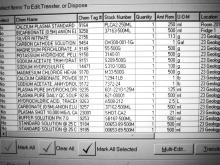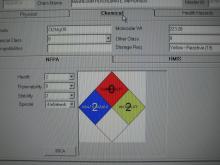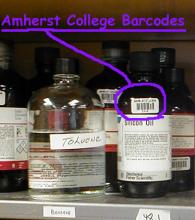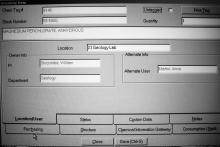Chemical Inventory Requirements
April 2022
The Emergency Planning and Community Right-to-Know Act (EPCRA) of 1986 established requirements for Federal, State, and Local Governments, as well as Indian Tribes, Businesses, Industries, Colleges and Universities regarding emergency planning and Community Right-to-Know reporting on hazardous and toxic materials.
EPCRA became a significant issue for Colleges and Universities in 1999 when the EPA Region 1 (New England) required all Colleges and Universities to comply with the requirements that began in 1986.
The goal was to help increase the public’s knowledge and access to information on chemicals at individual facilities, their uses and any known or potential releases into the environment, even through a fume or other exhaust system. States and their respective communities working with their respective facilities, including colleges and universities must provide and use this information to improve chemical safety and better protect health and the environment.
EPCRA falls under the requirements of EPA’s SARA Title III, which is a statute to improve community access to information about all chemical hazards, and to facilitate the development of chemical emergency response plans. EPCRA required the establishment of State emergency response commissions (SERCs), responsible for coordinating certain emergency response activities and for appointing local emergency planning committees (LEPCs), of which Amherst College is a member, as required.

To put this into better perspective, a university was initially fined $49,000.00 for the infraction referenced above and was ordered to come up with a program to properly inventory their chemicals and the disposal of same. When they were done, and had satisfied the EPA, the cost of their Chemical Inventory System, which is the same one we use (without some of the frills such as bar code scanners) the cost was $322,000.00.
In addition to the cost, it was a public relations problem for the university.
EPCRA has for major provisions under the Code of Federal Regulations 40 CFR Parts 350 - 372
- Emergency Planning (sections 301-303)
- Amherst College has the required All-Hazards Plan, which was required in November 2003
- Emergency Release Notification (section 304)
- Amherst College has policies and procedures in place, and has made notifications to the State DEP for such releases, such as for the accidental release of > 10 gallons of oil, both above and below grade.
- Hazardous Chemical Storage Reporting Requirements (sections 311-312)
- Amherst College had to identify all of our Main Accumulation Areas to the State and Federal Environmental Protection Agencies, the appropriate security measures we take, and is listed as a Large Quantity Generator (LQG) of Hazardous Waste because
of our generated facility and laboratory waste, and the amount of lead paint waste we are required to ship out and document.
- Amherst College had to identify all of our Main Accumulation Areas to the State and Federal Environmental Protection Agencies, the appropriate security measures we take, and is listed as a Large Quantity Generator (LQG) of Hazardous Waste because
Chemical Inventory (Section 313)
The Chemical Inventory is one of the biggest issues for our laboratories on campus.

It along with proper training, record-keeping and storage practices is the most cited violations for both the state and federal environmental protection agencies.
The Chemical Inventory forces all colleges and universities to evaluate their chemicals every 6 months to properly manage same.
It allows the college to easily report information to the public and government officials about the chemicals we have, how we manage the waste streams and releases, both accidental and through the hoods or other exhaust systems. The following information is required of us;
- The name. location and type of business
Ex: Amherst College, Life Sciences Room 406 and Education
- Whether the chemical is manufactured, imported, processed or used, as well as the categories of use of the chemical
- An estimate of the actual amounts of the chemical present at the facility during the preceding year
- Quantity of the chemical entering the air, land and water, annually
- Any off-site locations to which the facility transfers chemicals in waste for recycling, energy recovery, treatment or disposal; and
- Waste treatment/disposal methods, recycling, re-use, transfer and efficiency of methods for each waste stream
- In addition to the above, the Pollution Prevention Act of 1990 requires collection of information on source reduction, recycling and treatment.
- The Chemical Inventory requirement applies to any facility that has 10 or more full time employees (entire college) that manufacture, import, process or use chemicals, and that are required to meet one of 7 different sectors of the above referenced requirements. For Amherst College it is;
- Resource Conservation and Recovery Act (RCRA), Subtitle C Hazardous Waste Treatment and Disposal
EPCRA Penalties (EPCRA Section 325) allows civil and administrative penalties for non-compliance ranging from up to $10,000.00 - $75,000.00 per violation or per day per violation when a facility fails to comply with the reporting requirements. Criminal policies of up to $50,000.00 or 5 years in prison apply to any person who knowingly and willingly fails to provide emergency release notification, or penalties of not more than $20,000.00 and/or up to one year in prison apply to any person who knowingly and willfully discloses any information entitled to protection as a trade secret.
EPCRA Penalties (EPCRA Section 326) allows citizens (Amherst Residents through the local fire department) to initiate civil actions against EPA, State Emergency Response Commission (SERC) and the owner or operator of the facility (Amherst College) for failure to meet the requirements of EPCRA.
In addition to the above, the Chemical Inventory is required under the Clean Air Act, section 112 and the Toxic Substances Control Act (TSCA) 15 U.S.C. section 2601-2629.
- TSCA (under EPA) requires the Chemical Inventory System to include “chemical substances”
- Chemical Substances include; “any organic or inorganic substance of a particular molecular identity, including any combination of such substances occurring in whole or in part as a result of a chemical reaction, or occurring in nature and any element or uncombined radical”.
- TSCA only excludes the following:
- Radioactive Materials, which are covered under the NRC and Massachusetts Department of Public Health
- Commercials Pesticides, which are covered under Federal Insecticide, Fungicide and Rodenticide Act
- Tobacco and Tobacco Products
- Pistol, firearms, cartridges etc.
- Commercial Food, Drugs and Cosmetics, which are covered under the FDA
All of the information, including our list of chemicals, the appropriate Material Safety Data Sheets (MSDS), which the College maintains (provided by the Biology, Chemistry, Geology, Fine Arts, Theater and Physical Plant Departments) is managed by the Chemical Hygiene Office and the Office of Environmental Health and Safety. All of this information is placed on our SERC/LEPC database, which is forwarded (as required) annually to the local Fire Department (Amherst Fire Department), LEPC (Hampshire County) and the State Emergency Response Commission (SERC).
- The Chemical Inventory, which the CHO and EHS maintain for the College, with your assistance must identify the name of the chemicals, including, but not limited to salts, combustible and flammable liquids, ammonia, acids and bases, gases (including nitrogen and oxygen), lead paint and our winter sand which is kept in storage by the Power Plant as well as the CAS number (Chemical Abstract Service Number), the quantity, the hazard classification and the section under EPCRA that it must comply with, such as 301, 302, 303, 311, 312, 313 etc.
- The Chemical Inventory is used by the local emergency response teams (ambulance, police and fire, hazardous material response teams and the state DEP in case of emergency response.
- What does the College have, where is it located, and in what quantities.
- The Chemical Inventory System is also used by the State DEP and EPA to see how we manage our waste streams. Where is the material, what is it being used for, is it being properly stored and how is it disposed of.
- Ex: The Fine Arts Department saves all of the spray cans of Rustoleum Paint in a bucket (for the entire semester) so that we can count up how many cans were used within the paint spray booth in Fayerweather 005, over the course of the semester, and report same, as required.
- The Chemical Inventory System also identifies materials that the Federal Bureau of Investigation (FBI) checks up on, such as the diisopropylflurophosphine and tetradodoxin.
The EPA requires all college and university laboratories to have a Safety, Health and Environmental Management Program (SHEMP). It mandates that we perform surveys, job safety analysis, hazard reporting, inspections, accident investigations and injury and illness trends in the facilities. It includes a baseline identification of all hazards or potential hazards within the facilities, including chemicals.
Every laboratory must implement a system to manage the purchase of chemicals for the following reasons;
- To track materials coming into the laboratory, and identify same to the local emergency response agencies.
- To ensure that less-hazardous substitutions are considered where applicable.
- To ensure that laboratory personnel are evaluating their chemicals and containers every 6 months for leaks, spills, over-pressurizations, chemical compatibility, possible disposal, testing or reassignment to another area or laboratory to minimize the amount of waste generated.
- To identify the need for additional training, monitoring, or controls for the use and handling of a chemical
- To prevent overstocking of a chemical
- Depending on the business, industry, college or university and the structure of the laboratory, suitable options for managing chemical purchases may include the following (stand alone or combination of);
- Requiring a formal review and sign off by a designated, authorized individual before purchasing department will process an order for a chemical.
- Providing the purchasing department with a list of known chemicals (ordered in a certain manner, such as monthly in a specified quantity) that can be ordered without sign-off
- Requiring the purchase of all chemicals to go through a single, appropriately trained person within a laboratory, a safety officer, a chemical hygiene officer, a department manager etc.
- A single person could order, receive, distribute, track, obtain (if necessary) new or missing MSDS’s and would know if the department was either over stocked or low on the chemicals needed.
- Most laboratories opted for an electronic database (Jon Sanborn worked hard to identify the least burdensome system) to manage all of our chemicals.
The Chemical Inventory, management and control is the responsibility of all persons involved in chemical acquisition, use and disposition. This is just one of the state and federal mandated controls required to enhance safety, support regulatory compliance, reduce costs and lower risk. A bar code system, like the one we utilize on campus can deliver, with minimal work, the detailed inventory we are required to keep.
- Because the Chemical Inventory System that we use (Vertere) provides all of the necessary information with regard to the chemicals we purchase, all we need from the individual laboratory is;
- The placement of a bar code label on the bottle, container, cylinder, drum of a chemical that is ordered and delivered to campus.
- Building, room, professor etc. are already known, as he slip of paper we provided comes from a specified room, under the control of a specific person
- The date the chemical was received (increment), and
- The date the chemical container was emptied (decrement)
- The placement of a bar code label on the bottle, container, cylinder, drum of a chemical that is ordered and delivered to campus.
- The labeling system (bar code) has to be a campus standard, easy to use and consistently applied, and the labels must be suitable for the environment.
- The Chemical Inventory System provides us, and the local emergency response agencies with all of the other needed information such as total amount on campus, where the chemical is stored, NFPA Codes and Hazards, personal protective equipment required, where additional material may be found and a way of tracking chemical waste or “waste-like” material that we could be cited for.
What must be included on the Chemical Inventory:
- An initial inventory of all areas, including Physical Plant must be performed by a competent, trained and authorized person
- Initially, all unused, unwanted, “waste-like” materials should be disposed of through the Waste Management Program. Do not inventory materials you do not want.
- Evaluate the age, usefulness, packaging, labeling and storage conditions
- All chemicals that the PI wants to keep in stock for associated laboratory work.
- The regulations specify that all “hazardous” chemicals must be inventoried.
- The term “hazardous” is often debated, but the DEP, EPA and OSHA under 29 CFR 1910. 1200 and the General Duty Clause emphasize safety. Lead paint, Nitrogen, Ammonia, Chlorine, inhalation hazards (salts) all adversely affect persons and are considered “hazardous”
- The above rationale eliminates “gray areas”, as laboratory personnel are not required to try and identify what is hazardous and what is not.

Untagged Items
- Some chemicals may be inappropriate for tagging due to container size, storage requirements or inaccessibility. These items can be assigned a number and marked in the database as “Untagged”. The list (from the computer generated database) can be taped to a refrigerator or shelf, and is regulatory compliant.
- Leaving the decision about what should and should not be included to the end user can result in inconsistency and liability.
